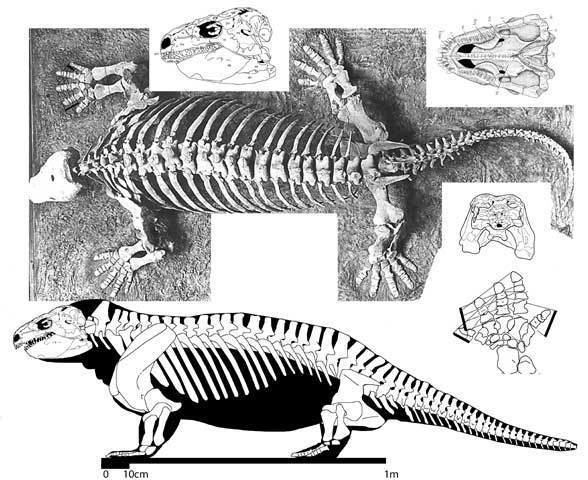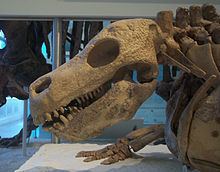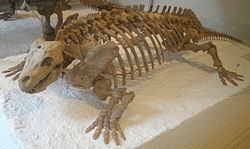Scientific name Diadectes | Family †Diadectidae Phylum Chordata Rank Genus | |
 | ||
Similar Diadectomorpha, Seymouria, Tetrapod, Limnoscelis, Orobates | ||
Diadectes (meaning crosswise-biter) is an extinct genus of large, very reptile-like amphibians that lived during the early Permian period (Cisuralian epochs, between 290 and 272 million years ago). Diadectes was one of the very first herbivorous tetrapods, and also one of the first fully terrestrial animals to attain large size.
Contents

Description

Diadectes was a heavily built animal, 1.5 to 3 meters long, with a thick-boned skull, heavy vertebrae and ribs, massive limb girdles and short, robust limbs. The nature of the limbs and vertebrae clearly indicate a terrestrial animal.
Paleobiology

It possesses some characteristics of reptilians and amphibians, combining a reptile-like skeleton with a more primitive, seymouriamorph-like skull. Diadectes has been classified as belonging to the sister group of the amniotes.
Among its primitive features, Diadectes has a large otic notch (a feature found in all labyrinthodonts, but not in reptiles) with an ossified tympanum. At the same time its teeth show advanced specialisations for an herbivorous diet that are not found in any other type of early Permian animal. The eight front teeth are spatulate and peg-like, and served as incisors that were used to nip off mouthfuls of vegetation. The broad, blunt cheek teeth show extensive wear associated with occlusion, and would have functioned as molars, grinding up the food. It also had a partial secondary palate, which meant it could chew its food and breathe at the same time, something many even more advanced reptiles were unable to do.
These traits are likely adaptations related to the animals' high-fiber herbivorous diet, and evolved independently of similar traits seen in some reptilian groups. Many of the reptile-like details of the post-cranial skeleton are possibly related to carrying the substantial trunk, these may be independently derived traits on Diadectes and their relatives. Though very similar, they would be anaologous rather than homologous to those of early amniotes like pelycosaurs and pareiasaurs, as the first reptiles evolved from small, swamp dwelling animals like Casineria and Westlothiana. The phenomenon of related animals evolving similarly is known as parallelophyly.
Discovery
Diadectes was first named and described by the American paleontologist Edward Drinker Cope in 1878, based on part of a lower jaw (AMNH 4360) from the Permian of Texas. Cope noted: "Teeth with short and much compressed crowns, whose long axis is transverse to that of the jaws," the feature expressed in the generic name Diadectes "crosswise biter" (from Greek dia "crosswise" + Greek dēktēs "biter"). He described the animal as "in all probability, herbivorous." Cope's Neo-Latin type species name sideropelicus (from Greek sidēros "iron" + Greek pēlos "clay" + -ikos) "of iron clay" alluded to the Wichita beds in Texas, where the fossil was found. Diadectes fossil remains are known from a number of locations across North America, especially the Texas Red Beds (Wichita and Clear Fork).
Classification and species
Numerous species have been assigned to Diadectes, though most of those have proven to be synonyms of one another. Similarly, many supposed separate genera of diadectids have been shown to be junior synonyms of Diadectes. One of these, Nothodon, was actually published by Othniel Charles Marsh five days before the name Diadectes was published by his rival Edward Drinker Cope. Despite this fact, in 1912 Case synonymized the two names and treated Diadectes as the senior synonym, which has been followed by other paleontologists since, despite the fact that it violates the rules of biological nomenclature.
Phylogeny
A phylogenetic analysis of Diadectes and related diadectids was presented in an unpublished Ph.D. thesis by Richard Kissel in 2010. Previous phylogenetic analyses of diadectids had found D. absitus to be more basal than other species of Diadectes, outside the derived clade composed of these species. In these analyses, Diasparactus zenos was more closely related to the other species of Diadectes than was D. absitus, making Diadectes paraphyletic. Kissel recovered this paraphyly in his analysis and proposed the new genus name "Silvadectes" for D. absitus. Below is the cladogram from Kissel's thesis:
However, according to the International Code of Zoological Nomenclature (ICZN), a name presented in an initially unpublished thesis such as Kissel's is not valid. Because the name "Silvadectes" has not yet been formally erected in a published paper, it is not currently considered valid.
